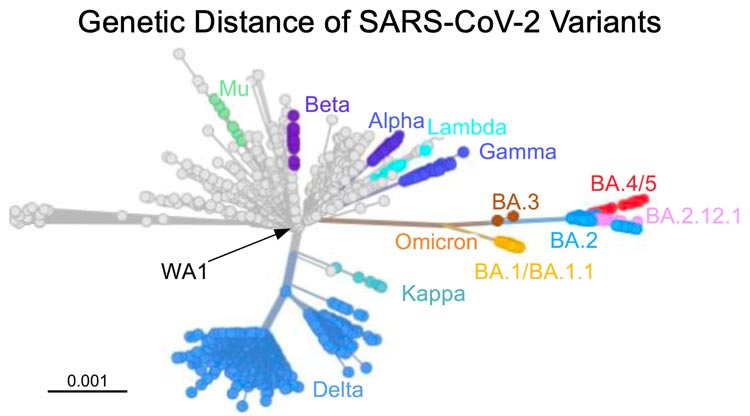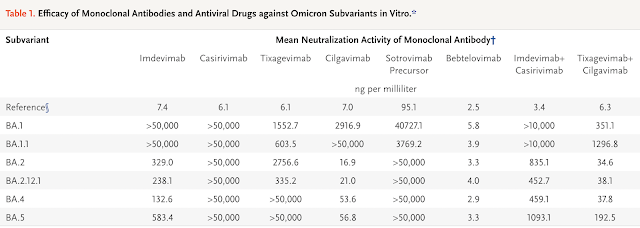Why BA.5 Is the King of Coronavirus Variants
Today, the CDC [U.S. Centers for Disease Control and Prevention] estimates the subvariant is responsible for about 54% of new cases here. That's double BA.2.12.1, which now accounts for 27% of infections. BA.5's rise also leaves sister subvariant BA.4 in the dust at 16%. It's a faster ascension than that of any other variant over the course of the pandemic ...
One reason BA.5 is so dominant is that it seems to be more transmissible than even BA.2.12.1 ... 'The Omicron sub-variant BA.5 is the worst version of the virus that we've seen,' said Eric Topal, who is Founder and Director of the Scripps Research Translational Institute, Professor of Molecular Medicine and Executive Vice-President of Scripps Research, in a substack post4 last week.
'It takes immune escape, already extensive, to the next level, and, as a function of that, enhanced transmissibility, well beyond Omicron (BA.1) and other Omicron family variants that we've seen.'
In other words, BA.5 is much better at evading the immunity provided by vaccines and especially good at dodging the immunity conferred by previous infection.5"
BA.5 Circumvents Previous Defenses
Even if you've had COVID before, got the jab and all your boosters, and even if you have hybrid immunity (meaning you've had both past infection and the COVID jab), chances are you'll probably catch BA.5, as it seems particularly adept at circumventing all previous defenses.
This immune-evading ability is likely an outgrowth of mass injection, as vaccinating a population during an acute outbreak pressures the virus to mutate more rapidly. The image below, from Topol's Substack article,6 illustrates the genetic distance between BA.5 and previous strains.

This scenario was predicted even before the mass injection campaign began, but no one in a position to make decisions paid any attention to reason. So, here we are.
What remains to be seen is whether BA.5 will cause worse or milder infection than Omicron, which was on par with the common cold. The problem we have is that governments around the world have done a spectacularly good job of undermining good data collection and reporting, so it's extremely difficult at this point to tease out what's really going on in the real world.
For example, in the U.S., COVID cases are at an "all-time low," Dr. Michael Mina, an epidemiologist and chief science officer at telehealth company eMed told CNN, July 11, 2022.7 However, that same day, NPR reported8 that BA.5 was "driving up cases and reinfections" in the U.S. So, which is it?
Europe, meanwhile, is reporting a sharp rise in both cases and hospitalizations.9 Keep in mind that "cases" simply refer to positive PCR tests, which are unreliable at best, as they cannot identify active infections, and COVID hospitalizations are frequently patients who are hospitalized for other conditions and just happen to test positive for COVID.
The only experimental study10 we have for BA.5 so far suggests the virus replicates more efficiently in human lung cell cultures than the Omicron subvariant BA.2, and infection experiments on hamsters suggest it may cause more severe infection than BA.2. That said, there's really no evidence to suggest BA.5 is deadlier than any previous version.11
BA.5 Triggers Calls for More Boosters
Despite the fact that BA.5 was a predicted outgrowth of pressure from mass "vaccination," governments around the world are doubling down on the failed strategy of boosters. As reported by Time magazine, July 11, 2022:12
"European regulators are urging second booster doses of COVID-19 vaccines for people over 60 years old as cases and hospitalizations are again rising sharply ... Weekly case rates among people age 65 and over increased 32% in 22 of the 24 reporting countries in the week ending July 3 compared to the previous week ...The [European Medicines] agency said that, at present, there is no clear evidence to support giving a second booster to people under 60 who are not at higher risk of severe disease ...
Separately, EMA Executive Director Emer Cooke said work is under way toward possible approval of vaccines adapted to counter newer variants in September."
Two days later, July 13, 2022, the Biden administration followed suit, announcing all adults, including those under 50, will be eligible for a second booster this fall, to quell worries about waning immunity. The announcement came just one week after Biden signed a $3.2 billion agreement with Pfizer for 105 million doses that will target Omicron subvariants BA.4 and BA.5.13
Effectiveness of Monoclonal Antibodies and Antiviral Drugs against Omicron BA.2.12.1, BA.4, and BA.5 Subvariants
Based on a lab study (NEJM, July 2022) using the live-virus Focus Reduction Neutralization Testing (FRNT) method, bebtelovimab seems to be the most promising monoclonal antibody against the BA 5 subvariant.

Overall, the study data also suggest that the three antiviral drugs remdesivir, molnupiravir, and nirmatrelvir (Paxlovid) may still have therapeutic value against the sublineages BA.2.12.1, BA.4, and BA.5 of SARS-CoV-2 omicron variants.

Do take note of the limitation of this study as this is a non-clinical study (not in humans). There is lack of clinical data on the efficacy of these monoclonal antibodies and antiviral drugs for the treatment of patients infected with BA.4 or BA.5 subvariants. Therefore, the selection of monoclonal antibodies or anti-virals to treat patients who are infected should be carefully considered based on the potential risks as compared to its potential benefits.


BA.5 May Soon Be Old News
Interestingly, as rapidly as BA.5 took over the world, it's already on pace to be replaced by another strain with the designation BA.2.75. In a second July 11, 2022, article, Time reported:14
"The quickly changing coronavirus has spawned yet another super contagious Omicron mutant ... BA.2.75 ... may be able to spread rapidly and get around immunity from vaccines and previous infection.It's unclear whether it could cause more serious disease than other Omicron variants, including the globally prominent BA.5 ... Fueling experts' concerns are a large number of mutations separating this new variant from Omicron predecessors.
Some of those mutations are in areas that relate to the spike protein and could allow the virus to bind onto cells more efficiently, [director of clinical virology at the Mayo Clinic, Matthew] Binnicker said.
Another concern is that the genetic tweaks may make it easier for the virus to skirt past antibodies — protective proteins made by the body in response to a vaccine or infection from an earlier variant."






.png)
Comments
Post a Comment